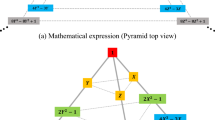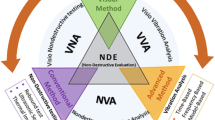Abstract
Nowadays, many non-destructive damage detection methods for determining the location and severity of damage in the field of health monitoring are considered in order to reduce the cost of maintenance and improve safety and reliability of structure. In this paper, damage specification is obtained by sensitivity-based updating approach. By applying changes on sensitivity matrix and using measured flexibility data, it is concluded that the results of proposed method are more accurate and efficient than the old modal flexibility methods. The mass modeling error and measurement error of flexibility and natural frequency are calculated in order to ensure the accuracy and robustness of proposed method for 2-D finite element truss and frame model. Close index, measuring the performance of the method, and the coefficient of variation, which represents the distribution of response, are used. Compared with Wang method, the proposed method is capable of accurately localizing and quantifying damage in all scenarios.




























Similar content being viewed by others
References
Doebling SW, Farrar CR and Prime MB et al (1996) Damage identification and health monitoring of structural and mechanical systems from changes in their vibration characteristics: a literature review. Research report, Los Alamos National Laboratory, USA
Araujo dos Santos JV, Maia NMM, Mota Soares CM et al (2008) Structural damage identification: a survey. Trends in computational structures technology. Saxe-Coburg Publications, Stirlingshire, pp 1–24
Fan W, Qiao P (2010) Vibration-based damage identification methods: a review and comparative study. Department of Civil and Environmental Engineering and Composite Materials and Engineering Center, Washington State University, Pullman, WA, pp 99164–2910
Law SS, Ni PH, Li J (2014) Parallel decentralized damage detection of a structure with subsets of parameters. AIAA J 52(3):650–656
Gudmundson P (1982) Eigenfrequency changes of structures due to cracks, notches, or other geometrical changes. J Mech Phys Solids 30(5):339–353
Sanayei M, Onipede O (1991) Damage assessment of structures using static test data. J AIAA 29(7):1174–1179
Wang X, Hu N, Fukunaga H, Yao ZH (2001) Structural damage identification using static test data and changes in frequencies. J Eng Struct 23(6):610–621
Bakhtiari-Nejad F, Rahai A, Esfandiari A (2005) A structural damage detection method using static noisy data. J Eng Struct 27(12):1784–1793
Esfandiari Akabr, Sanayei Masoud, Bakhtiari-Nejad Firooz, Rahai Alireza (2010) Finite element model updating using frequency response function of incomplete strain data. AIAA J 48(7):1420–1433
Abdo MAB (2012) Parametric study of using only static response in structural damage detection. J Eng Struct 34:124–131
Ni PH, Law SS (2016) Hybrid computational strategy for structural damage detection with short-term monitoring data. Mech Syst Signal Process 70–71:650–663
Seyedpoor SM, Yazdanpanah O (2014) An efficient indicator for structural damage localization using the change of strain energy based on static noisy data. J Appl Math Model 38:2661–2672
Sanayei M, Khaloo A, Gul M, Catbas FN (2015) Automated finite element model updating of a scale bridge model using measured static and modal test data. J Eng Struct 102:66–79
Lin CS (1990) Location of modeling errors using modal test data. J AIAA 28(9):1650–1654
Yan A, Golinval J-C (2005) Structural damage localization by combining flexibility and stiffness methods. J Eng Struct 27:1752–1761
Zhao J, Dewolf JT (1999) Sensitive study for vibrational parameters used in damage detection. J Eng Struct 125(4):410–416
Pandey AK, Biswas M (1994) Damage detection in structures using changes in flexibility. J Sound Vib 169(1):3–17
Guirong Y, Zhongdong D, Jinping O (2009) Damage detection for truss or frame structures using an axial strain flexibility. J Smart Struct Syst 5(3):291–316
Kim BH, Joong Joo H, Park T (2007) Damage evaluation of an axially loaded beam using modal flexibility. Struct Eng KSCE J Civ Eng 11(2):101–110
Li J, Wu B, Zeng QC et al (2010) A generalized flexibility matrix based approach for structural damage detection. J Sound Vib 329:4583–4587
Zhao B, Xu Z, Kan X, Zhong J, Guo T (2016) Structural damage detection by using single natural frequency and the corresponding mode shape. J Shock Vib 2016:8
Yan W, Ren W (2014) Closed-form modal flexibility sensitivity and its application to structural damage detection without modal truncation error. J Vib Control 20:1816–1830
Preumont A (2011) Vibration control of active structures: an introduction. Solid mechanics and its applications, vol 179, 3rd edn. Springer, Netherlands. https://doi.org/10.1007/978-94-007-2033-6
Fox RL, Kapoor MP (1968) Rates of change of eigenvalues and eigenvectors. J AIAA 6(12):2426–2429
Wang BP (1991) Improved approximate methods for computing eigenvector derivatives in structural dynamics. J AIAA 29(6):1018–1020
Doebling SW, Peterson LD, Alvin KF (1998) Experimental determination of local structural stiffness by disassembly of measured flexibility matrices. J Vib Acoust 120(9):49–57
Ren WX, De Roeck G (2002) Structural damage identification using modal data I: simulation verification. J Struct Eng 128(1):87–95
Author information
Authors and Affiliations
Corresponding author
Rights and permissions
About this article
Cite this article
Katebi, L., Tehranizadeh, M. & Mohammadgholibeyki, N. A generalized flexibility matrix-based model updating method for damage detection of plane truss and frame structures. J Civil Struct Health Monit 8, 301–314 (2018). https://doi.org/10.1007/s13349-018-0276-5
Received:
Accepted:
Published:
Issue Date:
DOI: https://doi.org/10.1007/s13349-018-0276-5




